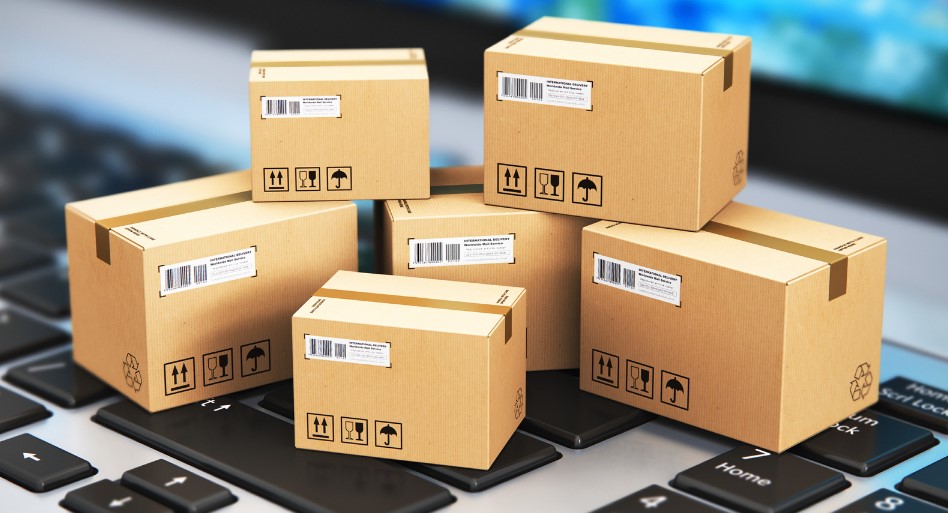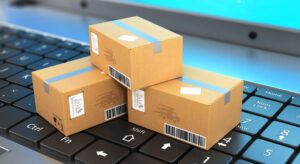
The Future of Ecommerce Shipping
Global B2C eCommerce reached $4.8 trillion in 2023, and it’s expected to nearly double to $9 trillion by 2032, with a compound annual growth rate of 7% between 2024 and 2027. This continued expansion will give brands more opportunities to thrive overseas, and introduce more sales channels. Fundamental to this is getting order fulfilment and delivery right, so what does the future hold for eCommerce logistics, and how can retailers capitalise on emerging trends and services to ride this tidal wave of growth?
The Future of Ecommerce Shipping
Prediction 1: Fulfilment Centres Will Become More Reliant on Automation and Robotics

Fulfilment warehouses are increasingly investing in robotics to accelerate order processing and increase picking accuracy. Pick and pack robots are powered by artificial intelligence to ensure the most suitable picking methods. By 2025, ABI Research predicts over 4 million robots will be installed in more than 50,000 warehouses, representing 1150% growth compared to 2018. The firm believes this will be driven by the need for greater efficiency and lower overheads, to make offering same-day delivery a realistic proposition.
Prediction 2: Logistics Firms Will Utilise AI to Power Inventory Analytics
AI can be used to help retailers make more profitable business decisions. For example, inventory control software can analyse past order frequencies, along with the rate of goods-in (the fulfilment centre receiving products in bulk from the manufacturer). This helps retailers avoid understocking, and missing out on sales, and overstocking, which can lead to capital unnecessarily tied up in goods, that could otherwise be better utilised.
Prediction 3: Customers Will Expect Greater Transparency Throughout the Delivery Journey
Consumers used to perceive speedy delivery as a luxury, but it’s now simply an expectation. A study by eBay found 59% of UK consumers expect their orders to arrive within two days, and 25% of shoppers expect next-day delivery. Faster delivery leads to happier customers, and later order cut-off times leads to more customers. Sellers offering one to three-day delivery on marketplaces experience sales uplift of around 7%.
In eCommerce, a transparent approach is critical, and a way you can achieve greater transparency is by giving your customers plenty of delivery tracking updates, and in-flight shipping options. The same research found 80% of consumers prefer at least four tracking updates throughout the delivery journey, as they give buyers greater confidence, reduce anxiety and help build trust. These trends will only increase for consumers as internet penetration and reliance rise.
Prediction 4: Consumers Will Demand Omnichannel
An omnichannel approach will become normalised, as consumers expect consistent, on-brand messaging across multiple sales channels and mediums. By investing in omnichannel eCommerce and marketing automation technology, retailers will be rewarded; omnichannel consumers spend 4% more in-store and 10% more online than those who are not, according to Sharpen.
Furthermore, 71%% of consumers demand an omnichannel customer experience, but only 29% say they actually get it. Businesses that invest in omnichannel technology see 91% higher customer retention than those who don’t, and these trends will continue into the future.
Prediction 5: Consumers Will Expect a Sustainable Approach
54% of online shoppers expect merchants to offer an eco-friendly delivery method, meaning it’s essential to work with carriers that focus on this. In the future, consumers will demand traceability, when it comes to packaging, shipping and returns, and will expect ethically-sound business practices for employees, throughout procurement, operations, and all other internal and external stakeholders.

Ecommerce sellers will be able to become more sustainable by making it their mission; offering green products that are sourced sustainably with Fair Trade, biodegradability, local sourcing and reusability taken into consideration. Retailers will also be able to become more sustainable through charitable giving, encouraging remote work, minimising waste throughout the supply chain, and becoming more energy-efficient.
Prediction 6: Retailers Will Demand Deeper Supply Chain Support
As competition amongst 3PLs increases, retail decision-makers are given more and more choice, encouraging fulfilment companies to diversify and offer complementary services, such as outsourced manufacturing, contact centre services, strategic consultancy, and procurement; rather than purely looking after order processing, 4PLs and 5PLs can help manage multiple fulfilment centres on behalf of the retailer or brand, and negotiate contracts on their behalf.
How to Capitalise on These Trends?
When looking for a suitable eCommerce logistics partner, it would be prudent to take these trends into account, and seek out a fulfilment centre that reinvests in developing its own technology, helping you gain more granular, actionable insights to help you make more profitable business decisions. 3PLs who offer additional services can help you scale your business further, and those offering eco-friendly initiatives, will save you from developing your own.
Author Profile
- Blogger by Passion | Contributor to many Business Blogs in the United Kingdom | Fascinated to Write Blogs in Business & Startup Niches |
Latest entries
 TechnologyMay 28, 2025What Customers Expect from a Modern Payment Experience Today?
TechnologyMay 28, 2025What Customers Expect from a Modern Payment Experience Today? TechnologyMay 28, 2025From BTC to USDT: How Different Cryptocurrencies Impact Your Casino Experience?
TechnologyMay 28, 2025From BTC to USDT: How Different Cryptocurrencies Impact Your Casino Experience? BusinessMay 2, 2025Improving Cash Flow with AI: A Smart Business Strategy for Better Financial Control
BusinessMay 2, 2025Improving Cash Flow with AI: A Smart Business Strategy for Better Financial Control BusinessMarch 26, 2025eCommerce Strategies to Reduce Returns You Can Leverage Today
BusinessMarch 26, 2025eCommerce Strategies to Reduce Returns You Can Leverage Today

